Project Management and Procurement Analysis Report
VerifiedAdded on 2020/02/23
|6
|1127
|69
Report
AI Summary
This report examines project procurement management, emphasizing the collaborative nature of project managers in planning and managing procurements. It analyzes key elements such as planning, conducting, administering, and closing procurements, highlighting their influence on controlling project risks. The report discusses the evolution of procurement processes, the impact of risk factors, and the importance of control levels in mitigating these risks. It explores how the style of contract and the acceptance of risks influence the procurement process, and how terms and conditions affect product quality and vendor responsibilities. The report also covers the influence of risk and control levels on the product procurement process, emphasizing how the balance between these factors impacts project outcomes. The analysis highlights the importance of clear specifications and terms to prevent uncertainty and ensure the delivery of desired outcomes.
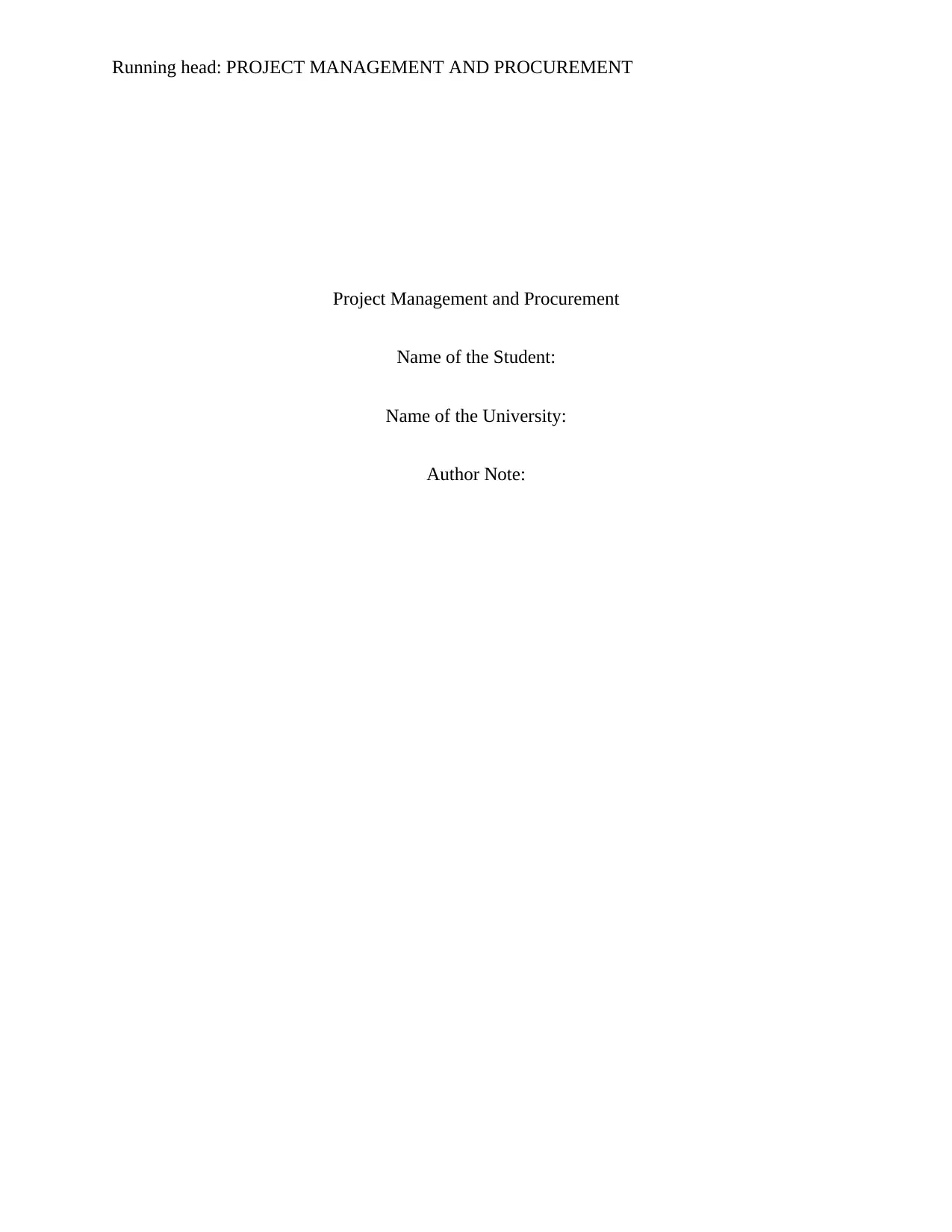
Running head: PROJECT MANAGEMENT AND PROCUREMENT
Project Management and Procurement
Name of the Student:
Name of the University:
Author Note:
Project Management and Procurement
Name of the Student:
Name of the University:
Author Note:
Paraphrase This Document
Need a fresh take? Get an instant paraphrase of this document with our AI Paraphraser
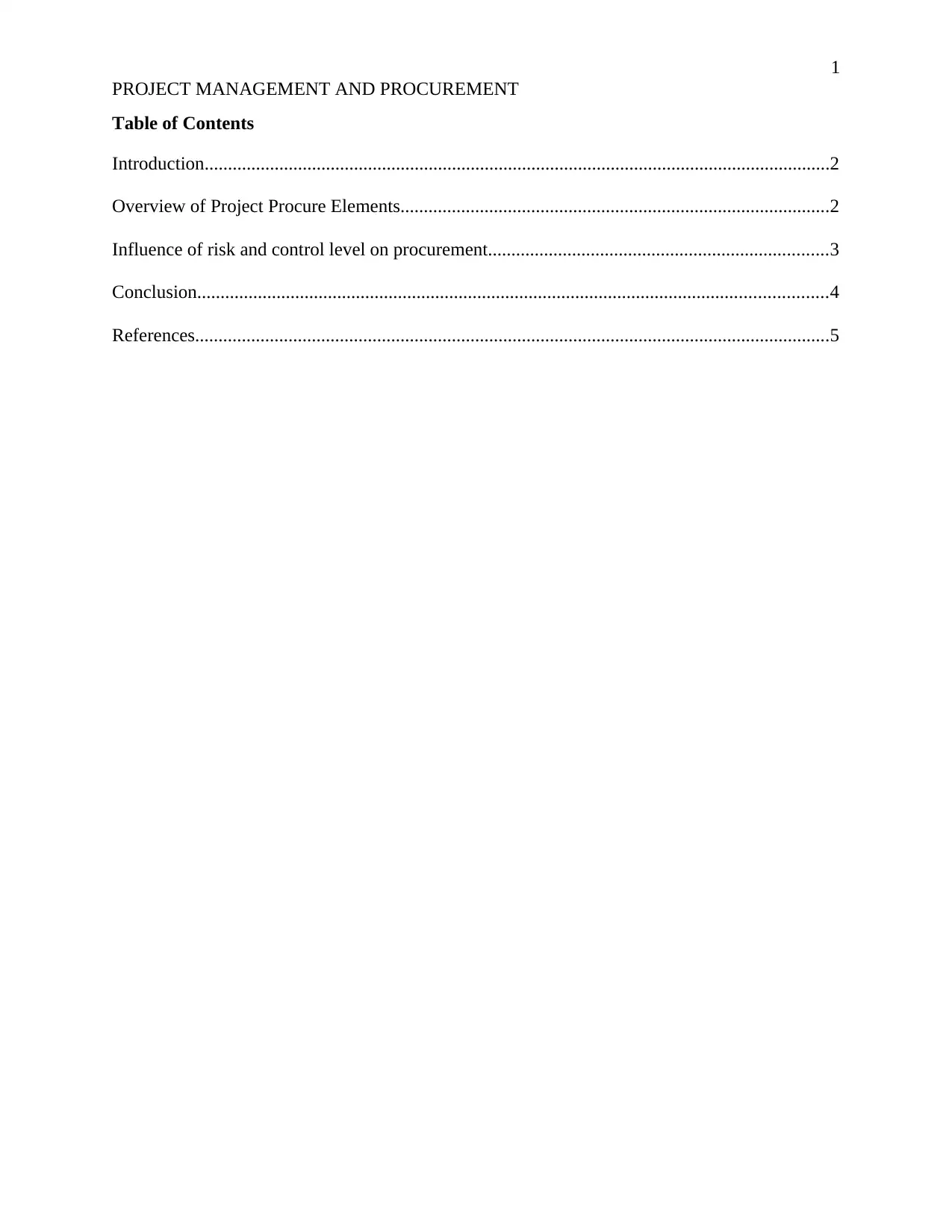
1
PROJECT MANAGEMENT AND PROCUREMENT
Table of Contents
Introduction......................................................................................................................................2
Overview of Project Procure Elements............................................................................................2
Influence of risk and control level on procurement.........................................................................3
Conclusion.......................................................................................................................................4
References........................................................................................................................................5
PROJECT MANAGEMENT AND PROCUREMENT
Table of Contents
Introduction......................................................................................................................................2
Overview of Project Procure Elements............................................................................................2
Influence of risk and control level on procurement.........................................................................3
Conclusion.......................................................................................................................................4
References........................................................................................................................................5
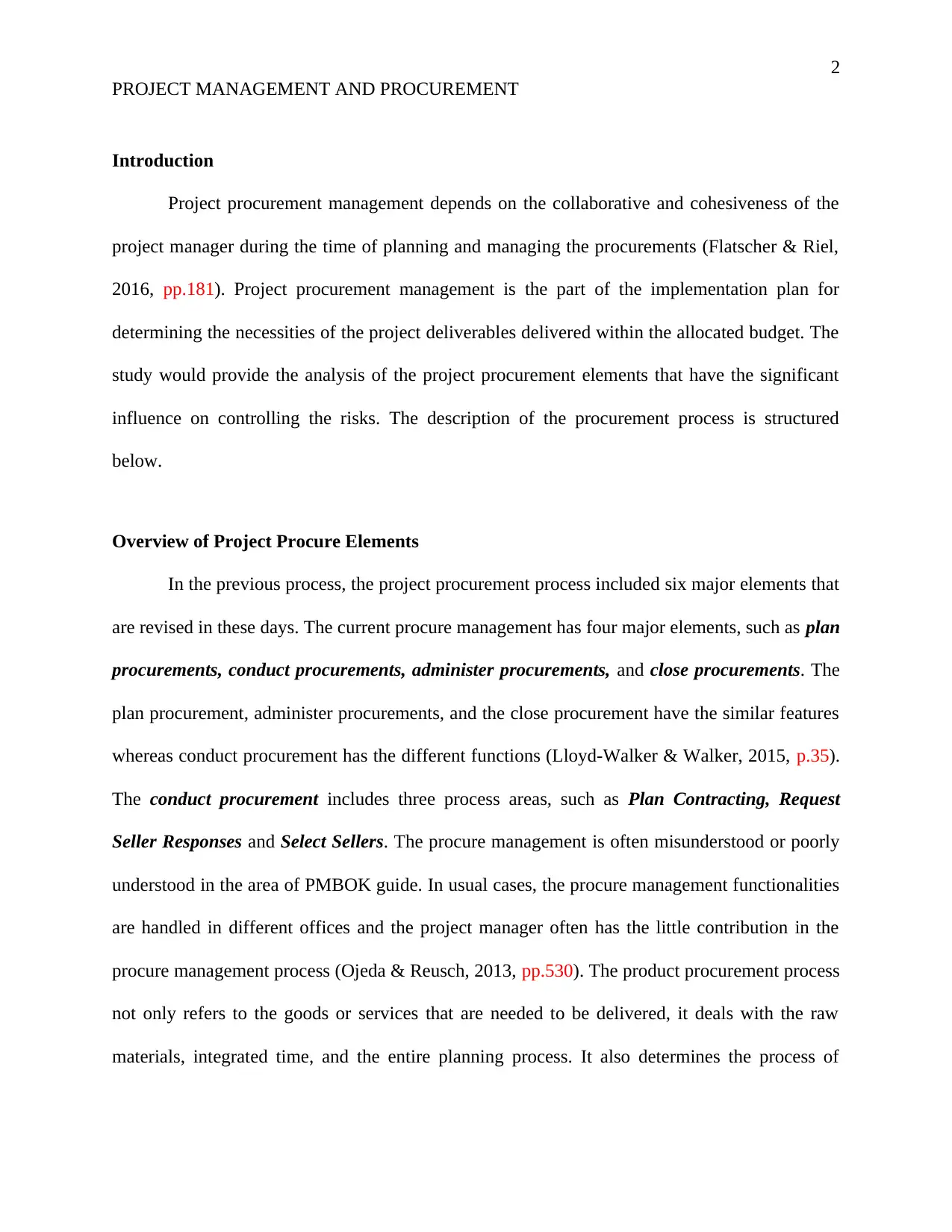
2
PROJECT MANAGEMENT AND PROCUREMENT
Introduction
Project procurement management depends on the collaborative and cohesiveness of the
project manager during the time of planning and managing the procurements (Flatscher & Riel,
2016, pp.181). Project procurement management is the part of the implementation plan for
determining the necessities of the project deliverables delivered within the allocated budget. The
study would provide the analysis of the project procurement elements that have the significant
influence on controlling the risks. The description of the procurement process is structured
below.
Overview of Project Procure Elements
In the previous process, the project procurement process included six major elements that
are revised in these days. The current procure management has four major elements, such as plan
procurements, conduct procurements, administer procurements, and close procurements. The
plan procurement, administer procurements, and the close procurement have the similar features
whereas conduct procurement has the different functions (Lloyd-Walker & Walker, 2015, p.35).
The conduct procurement includes three process areas, such as Plan Contracting, Request
Seller Responses and Select Sellers. The procure management is often misunderstood or poorly
understood in the area of PMBOK guide. In usual cases, the procure management functionalities
are handled in different offices and the project manager often has the little contribution in the
procure management process (Ojeda & Reusch, 2013, pp.530). The product procurement process
not only refers to the goods or services that are needed to be delivered, it deals with the raw
materials, integrated time, and the entire planning process. It also determines the process of
PROJECT MANAGEMENT AND PROCUREMENT
Introduction
Project procurement management depends on the collaborative and cohesiveness of the
project manager during the time of planning and managing the procurements (Flatscher & Riel,
2016, pp.181). Project procurement management is the part of the implementation plan for
determining the necessities of the project deliverables delivered within the allocated budget. The
study would provide the analysis of the project procurement elements that have the significant
influence on controlling the risks. The description of the procurement process is structured
below.
Overview of Project Procure Elements
In the previous process, the project procurement process included six major elements that
are revised in these days. The current procure management has four major elements, such as plan
procurements, conduct procurements, administer procurements, and close procurements. The
plan procurement, administer procurements, and the close procurement have the similar features
whereas conduct procurement has the different functions (Lloyd-Walker & Walker, 2015, p.35).
The conduct procurement includes three process areas, such as Plan Contracting, Request
Seller Responses and Select Sellers. The procure management is often misunderstood or poorly
understood in the area of PMBOK guide. In usual cases, the procure management functionalities
are handled in different offices and the project manager often has the little contribution in the
procure management process (Ojeda & Reusch, 2013, pp.530). The product procurement process
not only refers to the goods or services that are needed to be delivered, it deals with the raw
materials, integrated time, and the entire planning process. It also determines the process of
⊘ This is a preview!⊘
Do you want full access?
Subscribe today to unlock all pages.

Trusted by 1+ million students worldwide
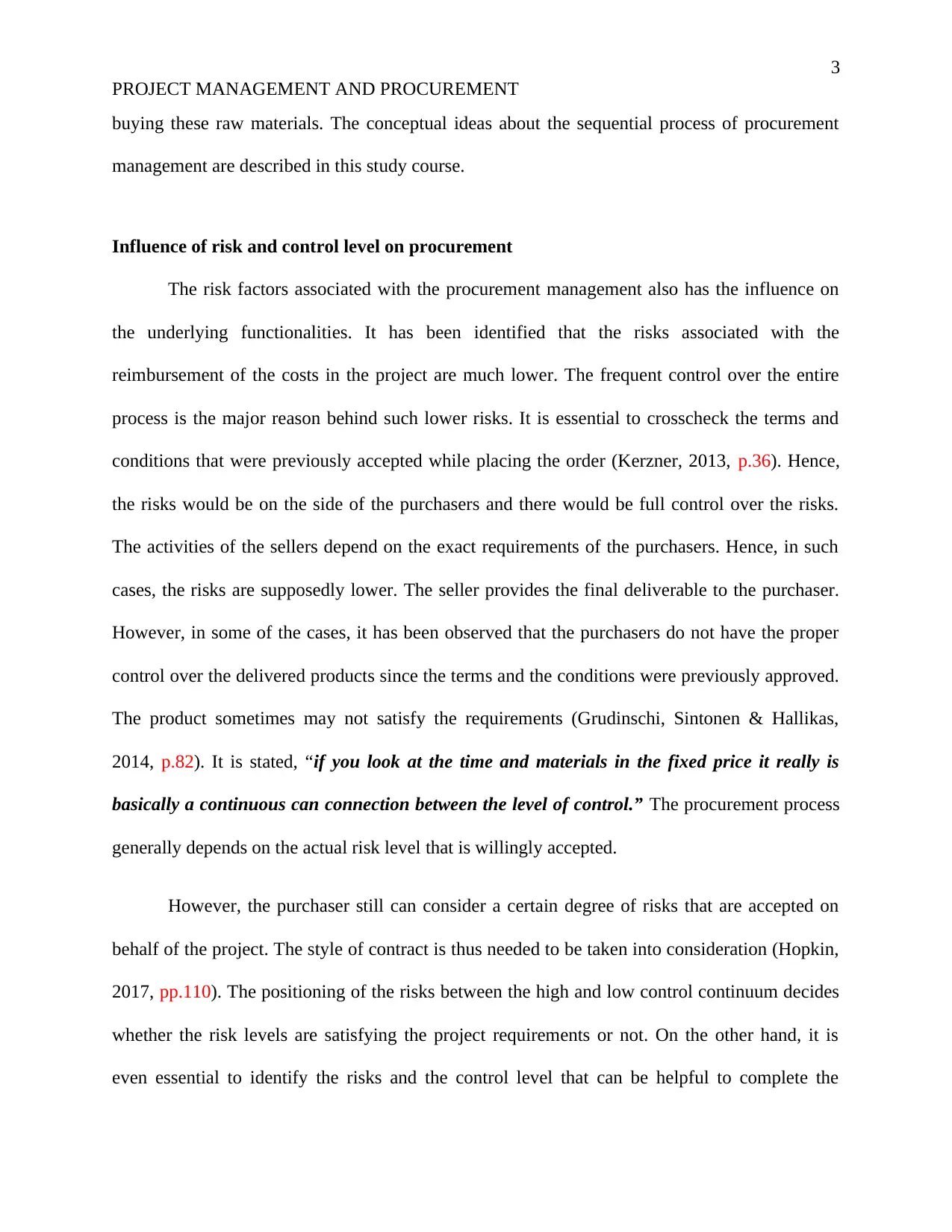
3
PROJECT MANAGEMENT AND PROCUREMENT
buying these raw materials. The conceptual ideas about the sequential process of procurement
management are described in this study course.
Influence of risk and control level on procurement
The risk factors associated with the procurement management also has the influence on
the underlying functionalities. It has been identified that the risks associated with the
reimbursement of the costs in the project are much lower. The frequent control over the entire
process is the major reason behind such lower risks. It is essential to crosscheck the terms and
conditions that were previously accepted while placing the order (Kerzner, 2013, p.36). Hence,
the risks would be on the side of the purchasers and there would be full control over the risks.
The activities of the sellers depend on the exact requirements of the purchasers. Hence, in such
cases, the risks are supposedly lower. The seller provides the final deliverable to the purchaser.
However, in some of the cases, it has been observed that the purchasers do not have the proper
control over the delivered products since the terms and the conditions were previously approved.
The product sometimes may not satisfy the requirements (Grudinschi, Sintonen & Hallikas,
2014, p.82). It is stated, “if you look at the time and materials in the fixed price it really is
basically a continuous can connection between the level of control.” The procurement process
generally depends on the actual risk level that is willingly accepted.
However, the purchaser still can consider a certain degree of risks that are accepted on
behalf of the project. The style of contract is thus needed to be taken into consideration (Hopkin,
2017, pp.110). The positioning of the risks between the high and low control continuum decides
whether the risk levels are satisfying the project requirements or not. On the other hand, it is
even essential to identify the risks and the control level that can be helpful to complete the
PROJECT MANAGEMENT AND PROCUREMENT
buying these raw materials. The conceptual ideas about the sequential process of procurement
management are described in this study course.
Influence of risk and control level on procurement
The risk factors associated with the procurement management also has the influence on
the underlying functionalities. It has been identified that the risks associated with the
reimbursement of the costs in the project are much lower. The frequent control over the entire
process is the major reason behind such lower risks. It is essential to crosscheck the terms and
conditions that were previously accepted while placing the order (Kerzner, 2013, p.36). Hence,
the risks would be on the side of the purchasers and there would be full control over the risks.
The activities of the sellers depend on the exact requirements of the purchasers. Hence, in such
cases, the risks are supposedly lower. The seller provides the final deliverable to the purchaser.
However, in some of the cases, it has been observed that the purchasers do not have the proper
control over the delivered products since the terms and the conditions were previously approved.
The product sometimes may not satisfy the requirements (Grudinschi, Sintonen & Hallikas,
2014, p.82). It is stated, “if you look at the time and materials in the fixed price it really is
basically a continuous can connection between the level of control.” The procurement process
generally depends on the actual risk level that is willingly accepted.
However, the purchaser still can consider a certain degree of risks that are accepted on
behalf of the project. The style of contract is thus needed to be taken into consideration (Hopkin,
2017, pp.110). The positioning of the risks between the high and low control continuum decides
whether the risk levels are satisfying the project requirements or not. On the other hand, it is
even essential to identify the risks and the control level that can be helpful to complete the
Paraphrase This Document
Need a fresh take? Get an instant paraphrase of this document with our AI Paraphraser
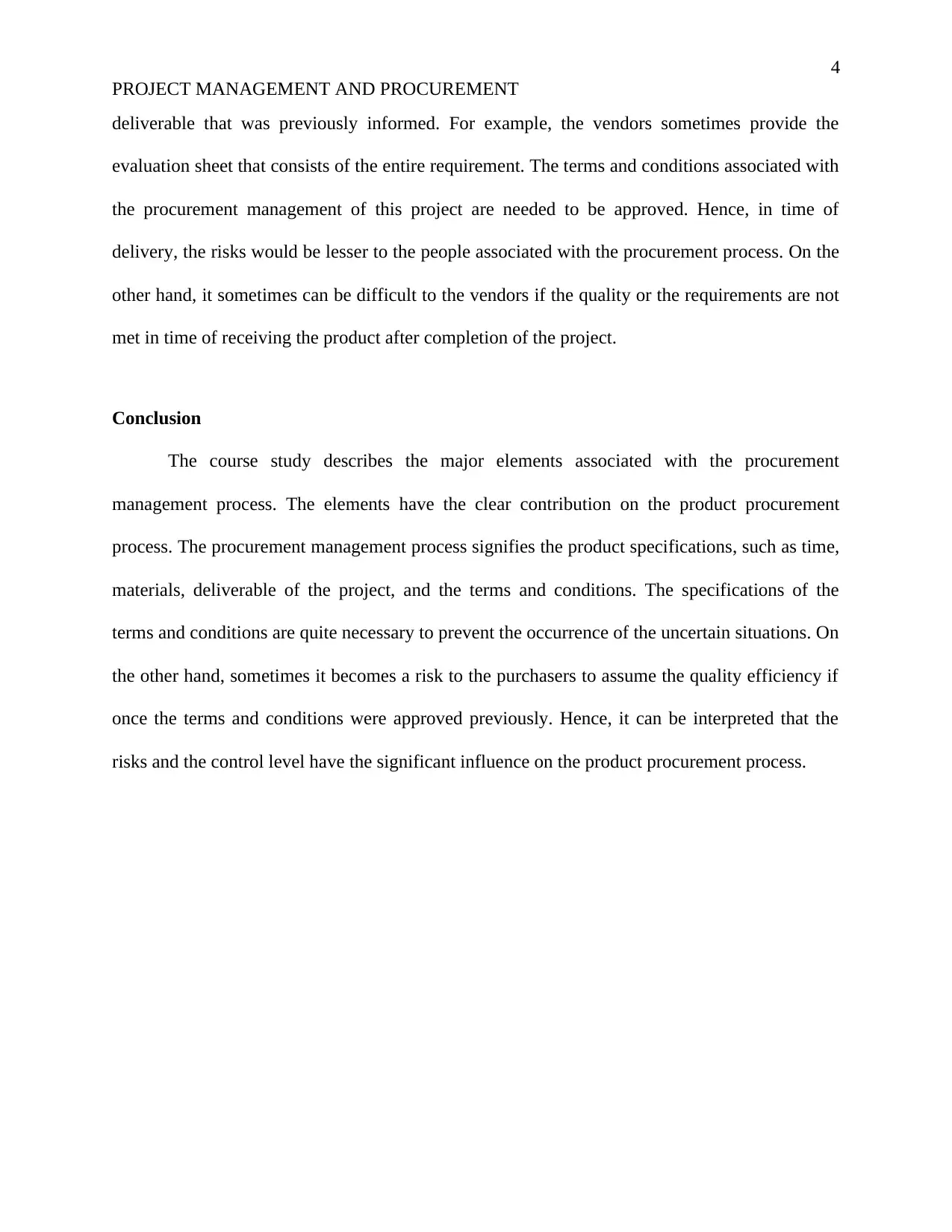
4
PROJECT MANAGEMENT AND PROCUREMENT
deliverable that was previously informed. For example, the vendors sometimes provide the
evaluation sheet that consists of the entire requirement. The terms and conditions associated with
the procurement management of this project are needed to be approved. Hence, in time of
delivery, the risks would be lesser to the people associated with the procurement process. On the
other hand, it sometimes can be difficult to the vendors if the quality or the requirements are not
met in time of receiving the product after completion of the project.
Conclusion
The course study describes the major elements associated with the procurement
management process. The elements have the clear contribution on the product procurement
process. The procurement management process signifies the product specifications, such as time,
materials, deliverable of the project, and the terms and conditions. The specifications of the
terms and conditions are quite necessary to prevent the occurrence of the uncertain situations. On
the other hand, sometimes it becomes a risk to the purchasers to assume the quality efficiency if
once the terms and conditions were approved previously. Hence, it can be interpreted that the
risks and the control level have the significant influence on the product procurement process.
PROJECT MANAGEMENT AND PROCUREMENT
deliverable that was previously informed. For example, the vendors sometimes provide the
evaluation sheet that consists of the entire requirement. The terms and conditions associated with
the procurement management of this project are needed to be approved. Hence, in time of
delivery, the risks would be lesser to the people associated with the procurement process. On the
other hand, it sometimes can be difficult to the vendors if the quality or the requirements are not
met in time of receiving the product after completion of the project.
Conclusion
The course study describes the major elements associated with the procurement
management process. The elements have the clear contribution on the product procurement
process. The procurement management process signifies the product specifications, such as time,
materials, deliverable of the project, and the terms and conditions. The specifications of the
terms and conditions are quite necessary to prevent the occurrence of the uncertain situations. On
the other hand, sometimes it becomes a risk to the purchasers to assume the quality efficiency if
once the terms and conditions were approved previously. Hence, it can be interpreted that the
risks and the control level have the significant influence on the product procurement process.
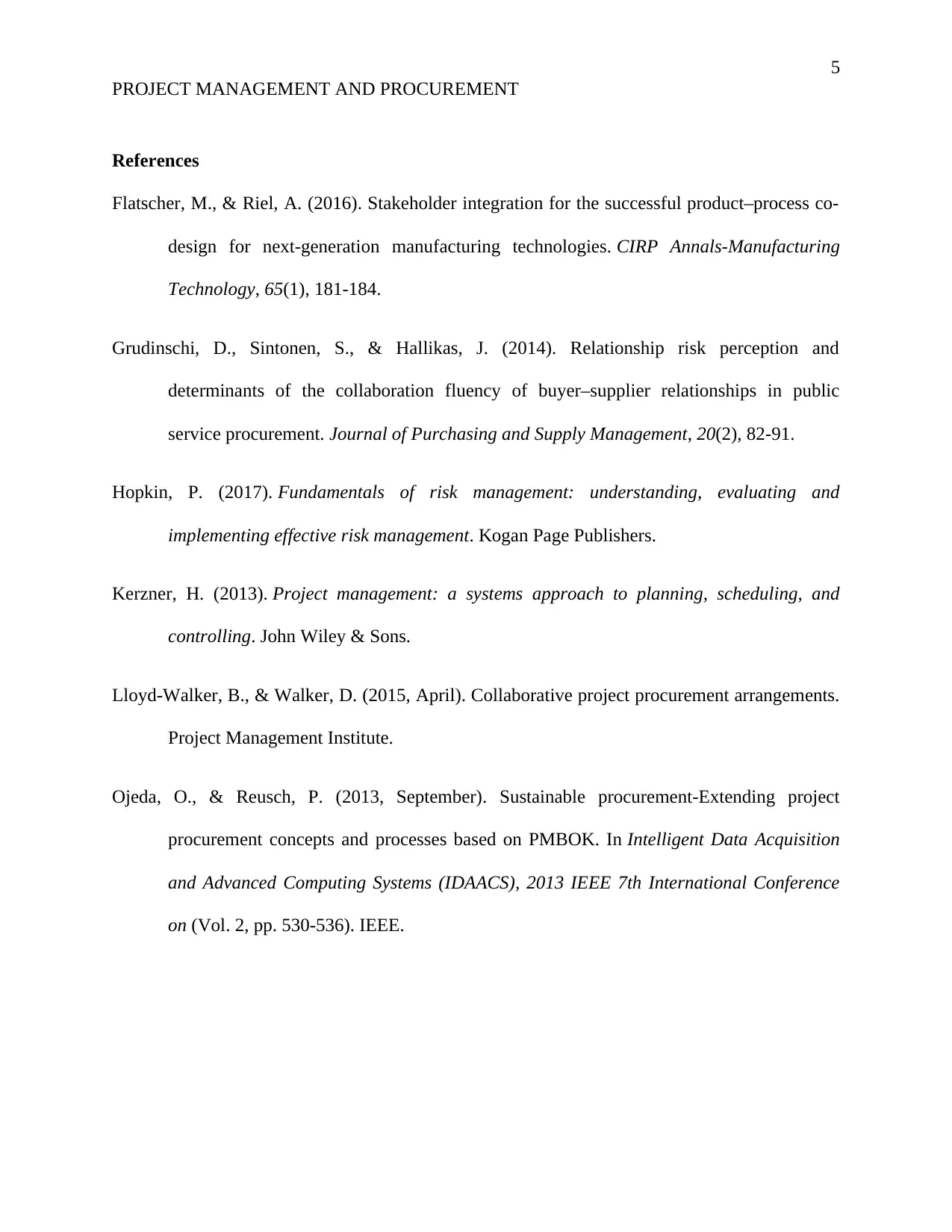
5
PROJECT MANAGEMENT AND PROCUREMENT
References
Flatscher, M., & Riel, A. (2016). Stakeholder integration for the successful product–process co-
design for next-generation manufacturing technologies. CIRP Annals-Manufacturing
Technology, 65(1), 181-184.
Grudinschi, D., Sintonen, S., & Hallikas, J. (2014). Relationship risk perception and
determinants of the collaboration fluency of buyer–supplier relationships in public
service procurement. Journal of Purchasing and Supply Management, 20(2), 82-91.
Hopkin, P. (2017). Fundamentals of risk management: understanding, evaluating and
implementing effective risk management. Kogan Page Publishers.
Kerzner, H. (2013). Project management: a systems approach to planning, scheduling, and
controlling. John Wiley & Sons.
Lloyd-Walker, B., & Walker, D. (2015, April). Collaborative project procurement arrangements.
Project Management Institute.
Ojeda, O., & Reusch, P. (2013, September). Sustainable procurement-Extending project
procurement concepts and processes based on PMBOK. In Intelligent Data Acquisition
and Advanced Computing Systems (IDAACS), 2013 IEEE 7th International Conference
on (Vol. 2, pp. 530-536). IEEE.
PROJECT MANAGEMENT AND PROCUREMENT
References
Flatscher, M., & Riel, A. (2016). Stakeholder integration for the successful product–process co-
design for next-generation manufacturing technologies. CIRP Annals-Manufacturing
Technology, 65(1), 181-184.
Grudinschi, D., Sintonen, S., & Hallikas, J. (2014). Relationship risk perception and
determinants of the collaboration fluency of buyer–supplier relationships in public
service procurement. Journal of Purchasing and Supply Management, 20(2), 82-91.
Hopkin, P. (2017). Fundamentals of risk management: understanding, evaluating and
implementing effective risk management. Kogan Page Publishers.
Kerzner, H. (2013). Project management: a systems approach to planning, scheduling, and
controlling. John Wiley & Sons.
Lloyd-Walker, B., & Walker, D. (2015, April). Collaborative project procurement arrangements.
Project Management Institute.
Ojeda, O., & Reusch, P. (2013, September). Sustainable procurement-Extending project
procurement concepts and processes based on PMBOK. In Intelligent Data Acquisition
and Advanced Computing Systems (IDAACS), 2013 IEEE 7th International Conference
on (Vol. 2, pp. 530-536). IEEE.
⊘ This is a preview!⊘
Do you want full access?
Subscribe today to unlock all pages.

Trusted by 1+ million students worldwide
1 out of 6
Related Documents
Your All-in-One AI-Powered Toolkit for Academic Success.
+13062052269
info@desklib.com
Available 24*7 on WhatsApp / Email
![[object Object]](/_next/static/media/star-bottom.7253800d.svg)
Unlock your academic potential
Copyright © 2020–2025 A2Z Services. All Rights Reserved. Developed and managed by ZUCOL.





